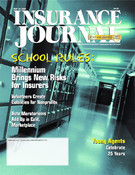For the past two months, Lloyd’s has been presenting evidence in the Jaffray case before Mr. Justice Cresswell in London, defending itself against allegations of fraud made by more than 200 “Names” (IJ March 20 and April 17). According to Lloyd’s spokesman Adrian Beeby, “our lawyers are even more confident now, after the presentation of evidence, than they were at the beginning.”
As Lloyd’s attorney Charles Aldous signaled in his opening presentation, the defense attacks the Names’ allegations that Lloyd’s management failed to disclose the enormous potential claims liabilities arising from asbestos, when they were encouraged to invest in syndicates. The evidence concentrates on proving that the peril was not hidden, but well known, and that the extent of the problem wasn’t initially discoverable, but became apparent over a period of time.
“There is no basis for alleging any information was withheld from the market,” Aldous stated. “Syndicate after syndicate reported it was affected by asbestos in underwriters’ reports. These reports were sent to Names and members’ agents. Time and again we say the chairman’s statements in annual reports referred to problems of asbestos in the non-marine markets. If members were unable or unwilling to study syndicate accounts, they should never have joined Lloyd’s in the first place.”
The British Commercial Court hearing the case is using a somewhat unusual procedure. Witness’ written statements are filed with the court as affidavits. This is similar in form to the U.S. federal rules and those of many state courts, which require full disclosure of a witness’ testimony to opposing parties, usually done through depositions. It amounts to filing a witness’ written testimony, and then cross-examination.
Thus the affidavit of Keith Rayment, an expert witness called by Lloyd’s, strongly disagreed with the Names’ key allegation, that Lloyd’s managers concealed facts concerning asbestos. From 1983 to 1990, which coincides with the period during which many Names joined Lloyd’s, Rayment, a principal in Keith Rayment Associates, a division of Aon Group Ltd. Claims Consultancy, was a member of the London market’s Asbestos Working Party (AWP), an industry group charged with evaluating asbestos claims.
Rayment stated: “It can fairly be said that as a result of the AWP’s efforts and the information that was publicly available, there was nothing hidden from the market. Information was freely available to those who had written risks which were subject to asbestos claims, and this information was available and provided to syndicates.
“In these circumstances, I cannot see how it would have been possible for Lloyd’s to try to conceal or cover up the extent of the problem,” his testimony continued. “I certainly never heard any suggestion that this was what was happening, and to the best of my knowledge it did not happen.”
Rayment didn’t downplay the scope of the asbestos problem, which still results in around 60,000 new claims a year, but indicated that the scale and the costs couldn’t be accurately estimated at the time.
“The plain truth is that, notwithstanding the wealth of experience and expertise that the Lloyd’s Market had, and the enormous resources and effort which the market threw into dealing with the problem, asbestos claims developed in a way which was not expected or anticipated by even the most experienced professionals in the Lloyd’s Market,” Rayment concluded.
Part of the difficulty in estimating the potential liability arose from the decisions of American courts. Their rulings interpreted policy language to include asbestos claims, which had not been foreseen when the policies were actually written.
Addressing this aspect of the lawsuit, another Lloyd’s witness, Alan Lord, chief executive from March 1986 to June 1992, stated: “During my period as chief executive, I think my concern was the extent to which the Americans were extending the coverage of long-term liabilities into areas which the policies affected had never been intended to cover.”
On May 15, Murray Lawrence, Lloyd’s former Chairman, took the stand and defended his affidavit. His testimony was particularly important, as one of the allegations made against Lloyd’s concerned a letter he wrote, warning of potentially huge asbestos-related liabilities, which the Names allege was effectively buried and its contents suppressed.
According to reports in the Financial Times, Lawrence vigorously defended his record as Chairman. Denying any efforts to cover up the asbestos situation, and asserting that the letter he wrote was circulated to all parties concerned, he is quoted as saying: “There was never any attempt to hide these issues from Names or to suppress discussion or debate on the issue of asbestos.”
Lawrence also denied allegations that he had tried to bribe or influence other Lloyd’s members, notably John Osbrey, a prominent Name, who had alleged that he was approached by Lawrence and offered debt credits in return for his silence. Osbrey, who died in 1999, had also accused Lawrence of threatening him if he testified against Lloyd’s. Lawrence dismissed his allegations, calling them “absurd.”
The case is expected to continue until early July, with a judgement due in September or October. It’s still unclear whether the Names will be able to prove that they were actively deceived, or whether Lloyds’ contentions, that sufficient information was made available concerning asbestos, will prevail. Even if Lloyd’s succeeds in London, the burden of proof isn’t necessarily the same as that which may apply in pending U.S. cases.
Topics Excess Surplus Lloyd's London
Was this article valuable?
Here are more articles you may enjoy.


 Allstate Seeking 34% Rate Hike on California Homeowners Insurance
Allstate Seeking 34% Rate Hike on California Homeowners Insurance  US P/C Underwriting Results: Two Years in a Row Over $20 Billion in the Red
US P/C Underwriting Results: Two Years in a Row Over $20 Billion in the Red  CSU Research Team Increases Atlantic Hurricane Forecast
CSU Research Team Increases Atlantic Hurricane Forecast  Hurricane Beryl Triggers Record Payout for Caribbean Insurer
Hurricane Beryl Triggers Record Payout for Caribbean Insurer 


